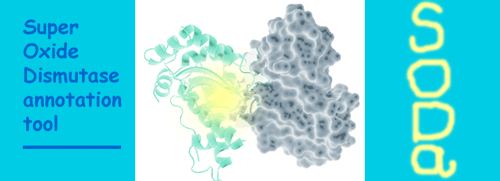SODa
SUPEROXIDE DISMUTASE ANNOTATION TOOL
predicts whether or not a sequence is an Fe/Mn superoxide
dismutase (sod). If so, it predicts in addition its metal ion specificity (Fe, Mn, or cambialistic),
and its oligomeric mode (dimeric or tetrameric).
SODa also proposes a list of residue mutations likely to modulate or improve
the sod-characteristics or the preference
for the metal cofactor or oligomerization mode.
The prediction method is based on a series of residue and interaction
fingerprints, derived from a set of aligned sod sequences and structures.
Several types of fingerprints can be distinguished:
(1) Residues and interacting residue pairs
that are conserved across the whole set of aligned sod sequences. A necessary
condition for a target sequence to be predicted as sod is that it contains all
these fingerprints.
(2) Residues and interacting residue pairs
that are conserved in at least 80% of the aligned sod sequences. A necessary
condition for a target sequence to be predicted as sod is that it contains a
sufficient number of these fingerprints.
(3) Residues and interacting residue pairs that occur in at least 80% of the
aligned sod sequences of a given type, and in less than 20% of the
others. The sod types considered are Fe-specific, Mn-specific, dimer,
tetramer, Fe dimer, Fe tetramer, Mn dimer, Mn tetramer, all but Fe dimer, all
but Fe tetramer, all but Mn dimer, all but Mn tetramer. A target sequence is
predicted to be of the sod type with the most matching fingerprints.
The complete list of fingerprints used by SODa is given
here.
All further details can be found in the articles:
Mn/Fe superoxide dismutase interaction fingerprints and prediction of oligomerization and metal cofactor from sequence.
Wintjens R, Gilis D, Rooman M.
Proteins, 70:1564-77 (2008).
Medline
SODa: an Mn/Fe SuperOxide Dismutase annotation tool.
Kwasigroch JM, Wintjens R, Gilis D, Rooman M.
BMC Bioinformatics. 2008 Jun 2;9:257.
Medline

